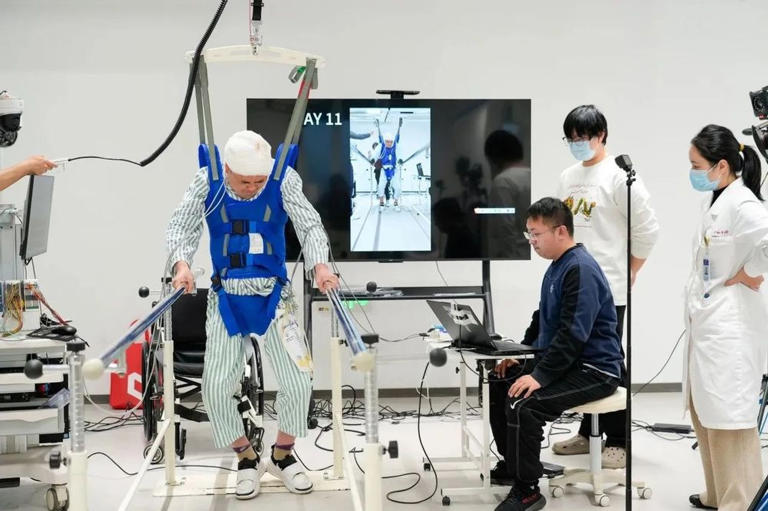Neurotechnology is rapidly changing the way we treat paralysis. For years, spinal cord injuries have been considered irreversible. Even advanced brain-computer interfaces (BCIs), like those developed by Elon Musk’s Neuralink, have focused on bypassing damaged nerves rather than restoring function to paralyzed limbs. However, a new clinical trial in China is proving that paralysis may not be permanent after all.
Table of Contents
A Revolutionary Trial in China
A team of researchers at Shanghai’s Fudan University recently made an incredible breakthrough. Four patients who had been paralyzed for years regained control of their legs within 24 hours of undergoing a minimally invasive surgery. Unlike previous BCIs, which connect the brain to external devices, this new technology repairs the body’s own nervous system.
The secret behind this success lies in tiny electrode chips implanted in the brain and spinal cord. These chips create a “neural bypass,” allowing signals to travel through damaged areas and reawaken dormant nerves. This process, known as “neural remodeling,” enables patients to regain muscles control naturally, rather than relying on external robotic assistance.
How Neurotechnology Work?
The procedure involves implanting two electrode chips, each just 1, in diameter, into the patient’s motor cortex. These chips collect and decode brain signals, stimulating specific spinal nerve roots to restore movement. Unlike previous methods, which could take months to show progress, patients in this trial experienced improvement within days.
One of the first patients, a 34 years old man who had been paraplegic for two years, underwent the surgery on January 8. Within 24 hours, he could lift both legs. By the 14th day, he could step over moving obstacles and walk more than five meters with support. Other patients who underwent the surgery in February and March also showed significant recovery.
Importance of Neurotechnology
This new brain-spinal interface offers several advantages over existing neurotechnology:
- Restores Natural Movement: Unlike BCIs that control robotic limbs, this technology helps the body repair itself.
- Fast Recovery: Neural remodelling effects appeared within two weeks, compared to six months in previous studies.
- Less Invasive Surgery: The procedure uses fewer implants, reducing potential damage to brain tissue.
- Made in China: All instruments and implants used in the surgery were developed domestically, showcasing China’s advancements in medical technology.
The Future of Neurotechnology
With millions of people suffering from spinal cord injuries worldwide, this discovery has the potential to change countless lives. In China alone, 3.74 million people live with spinal cord injuries, and around 90,000 new cases are reported each year. If further research confirms the effectiveness of this method, it could revolutionize paralysis treatment and offer new hope to patients worldwide.
Lead scientist Jia Fumin believes that by combining spinal interfaces with there to five years of rehabilitation, patients could completely regain independence. This means that neurotechnology may not only restore movement but also eliminate the need for permanent external devices.
Conclusion
The advancements in neurotechnology are redefining what is possible for patients with spinal cord injuries. This groundbreaking research from China challenges the dominance of Western countries in the field and opens new doors for innovative treatments. As scientists continue to develop this technology, we may soon see a world where paralysis is no longer a life sentence but a condition that can be reversed.
This incredible progress in neurotechnology is a beacon of hope for millions, proving that the human body has the potential to heal itself with the right tools and scientific innovation.


1 thought on “Neurotechnology: China’s Breakthrough in Restoring Movement to Paralyzed Patients”